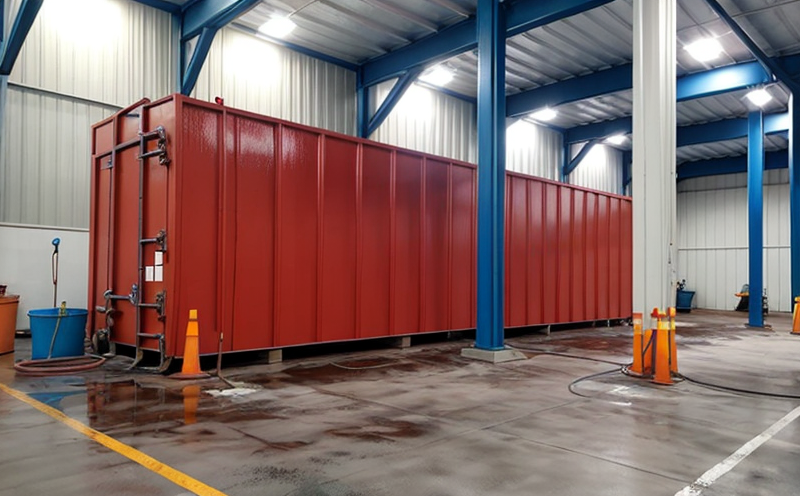Combustion Toxicity Indicator Test
The Combustion Toxicity Indicator Test is a critical analytical procedure designed to evaluate the potential toxicity of combustion products generated by industrial coatings, paints, and corrosion protection materials. This test assesses the air quality implications during fires or other combustion events involving these materials, ensuring compliance with international safety standards.
In industrial manufacturing and processing, protective coatings are used extensively to prevent corrosion, extend product life, and enhance operational efficiency. However, when exposed to high temperatures in a fire scenario, these materials may release harmful compounds into the air. The Combustion Toxicity Indicator Test quantifies these emissions, providing essential data for compliance with regulations like ISO 13400:2015 on automotive coating emissions.
The test procedure involves subjecting the coated specimens to controlled combustion conditions in a specialized chamber. Gas sampling is conducted simultaneously at various points within the combustion environment. Analytical instruments such as gas chromatography-mass spectrometry (GC-MS) and Fourier transform infrared spectroscopy (FTIR) are used for precise identification and quantification of toxic compounds.
The primary objective is to determine the levels of key pollutants, including carbon monoxide (CO), hydrogen cyanide (HCN), nitrogen oxides (NOx), and volatile organic compounds (VOCs). The test also evaluates the formation of polycyclic aromatic hydrocarbons (PAHs) and dioxins, which are particularly hazardous due to their long-term health impacts.
The acceptance criteria for this test strictly adhere to relevant standards such as ASTM E2349-18. Compliance with these stringent requirements ensures that industrial coatings do not compromise air quality during emergencies or operational failures. The results of the Combustion Toxicity Indicator Test are essential inputs for risk assessment and mitigation strategies in industrial settings.
Industry Applications
| Application Area | Description |
|---|---|
| Aerospace | Evaluating coatings for aircraft interiors and fuel tanks to ensure safety during fires. |
| Automotive | Testing paints used in vehicle bodywork to prevent rusting while minimizing fire risks. |
| Offshore Oil & Gas | Assessing corrosion protection layers on offshore structures for operational reliability and safety. |
| Chemical Processing | Evaluating protective coatings in refineries to prevent fires and minimize emissions during combustion events. |
The Combustion Toxicity Indicator Test is indispensable in these sectors, where the integrity of industrial coatings plays a pivotal role in preventing fires and ensuring air quality. By identifying potential toxic compounds early on, manufacturers can refine their formulations to meet stringent safety standards.
Quality and Reliability Assurance
- Sampling Precision: Rigorous sample collection methods ensure accurate representation of the combustion environment.
- Data Accuracy: Utilizing advanced analytical instruments like GC-MS and FTIR guarantees precise measurement of toxic compounds.
- Reproducibility: Consistent test results across multiple trials enhance reliability for decision-making purposes.
The test procedure is designed to minimize errors, ensuring that the reported values are reliable indicators of actual combustion toxicity. This consistency in testing methods and equipment calibration is crucial for maintaining quality assurance standards.
Regular audits by independent laboratories ensure that the testing process adheres to established protocols. These audits provide confidence in the accuracy of the test results and help prevent potential compliance issues with international standards like ISO 14001:2015 on environmental management systems.
Customer Impact and Satisfaction
- Risk Mitigation: By identifying toxic emissions early, manufacturers can implement corrective measures to enhance product safety.
- Regulatory Compliance: Meeting stringent international standards ensures that products meet regulatory requirements, thereby enhancing customer trust.
The results of the Combustion Toxicity Indicator Test directly impact customer satisfaction by ensuring that industrial coatings and paints are safe for use in high-risk environments. This test not only protects end-users but also strengthens brand reputation among consumers and regulatory bodies alike.
Customers benefit from products that meet stringent safety standards, reducing the likelihood of incidents leading to harm or environmental damage. The comprehensive nature of this testing ensures that manufacturers deliver reliable and safe solutions across various industrial sectors.





